Abstract
This study presents an integrated workflow for the characterization of fault-controlled fractured–vuggy reservoirs, demonstrated through a comprehensive analysis of the TP12CX fault zone in the Tahe Oilfield. The methodology establishes a four-element structural model—comprising the damage zone, fault core, vuggy zone, and cavern system—coupled with a multi-attribute geophysical classification scheme integrating texture contrast, deep learning, energy envelope, and residual impedance attributes. This framework achieves a validation accuracy of 91.2%. A novel structural element decomposition–integration approach is proposed, combining deterministic structural reconstruction with facies-constrained petrophysical modeling to quantify reservoir properties. The resulting models identify key heterogeneities, including caverns (Φ = 17.8%, K = 587 mD), vugs (Φ = 3.5%, K = 25 mD), and fractures (K = 1400 mD), with model reliability verified through production history matching. Field application of an optimized nitrogen foam flooding strategy, guided by this workflow, resulted in an incremental oil recovery of 3292 tons. The proposed methodology offers transferable value by addressing critical challenges in karst reservoir characterization, including seismic resolution limits, complex heterogeneity, and late-stage development optimization in fault-controlled carbonate reservoirs. It provides a robust and practical framework for enhanced oil recovery in structurally complex carbonate reservoirs, particularly those in mature fields with a high water cut.
1. Introduction
Carbonate fracture–cavity reservoirs represent one of the most significant types of carbonate reservoirs, exhibiting substantial hydrocarbon exploration and development potential [1]. The reservoir media in fracture–cavity systems encompass diverse types, including caverns, vugs, and fractures, demonstrating discontinuous spatial distribution patterns [2,3]. Based on the relative dominance of karstification and faulting during reservoir formation, fracture–cavity reservoirs can be further classified into epigene karst type, fault-controlled karst type, and fault-controlled type [4,5,6,7,8]. Typical examples include Blocks 4 and 6 in the Tahe Oilfield as representative epigene karst fracture–cavity reservoirs; the Tuoputai area of Tahe Oilfield, dominated by fault-controlled karst fracture–cavity reservoirs; and the Shunbei Oilfield, categorized as fault-controlled fracture–cavity hydrocarbon reservoirs.
Numerous studies have investigated reservoir architecture patterns, geophysical characterization methods, and geological modeling techniques for fracture–vuggy reservoirs [7,9,10,11,12,13]. Taking fault-controlled karst reservoirs as an example, Lu Xinbian et al. [5,7] classified reservoir configurations into ribbon-shaped, sandwich-cake-shaped, and slab-type traps based on spatial distribution patterns, while systematically documenting developmental environments, reservoir types, and production characteristics. Han Jianfa et al. [14] categorized reservoir distributions into linear, zonal, and feather-like patterns through strike-slip fault structural analysis. Zhang Wenbiao et al. [15] established a four-tier architectural classification system consisting of strike-slip fault damage zones, fault-controlled karst bodies, internal fracture–vug complexes, and cavern fillings, along with corresponding geophysical identification methods. Liu Jun et al. [16] optimized seismic techniques including trend surface analysis, detailed coherence, ant-tracking, and natural likelihood volumes for multi-scale fault prediction. Liu Baozeng and Li Haiying [17,18] developed an integrated characterization workflow combining structure tensor analysis, coherence-based fault extraction, acoustic impedance inversion, and impedance–porosity transforms. Hu Xiangyang et al. [19,20] proposed a two-phase modeling approach utilizing deterministic methods for large-scale features and stochastic simulations for small-scale elements under karst facies constraints. Li Yongqiang et al. [21] implemented multiple-point statistical algorithms with well-derived hard data and probabilistic constraints for small cavern modeling. Zhang Wenbiao et al. [22,23,24] created a hierarchical modeling framework incorporating “stratigraphic constraints, genetic controls, and progressive modeling” principles. However, existing research primarily focuses on trap-scale reservoir characterization, with proposed geophysical methods proving inadequate for reservoir unit-scale delineation. Current geological modeling efforts remain concentrated on reservoir geometry reconstruction, lacking systematic methodologies for porosity, permeability, and saturation modeling in fracture–vuggy systems.
This study focuses on the TP12CX fault zone in the Tuoputai area of the Tahe Oilfield, primarily targeting Ordovician strata categorized as fault-controlled karst fracture–vuggy reservoirs (Figure 1). With nearly 20 years of development history, the study area has reached an average water cut of approximately 60%, while some key production units exceed 80% water cut, entering a comprehensive adjustment phase of water flooding and gas injection [25,26,27]. This necessitates urgent implementation of refined reservoir characterization to support development technical policy formulation. Building on previous fault–karst reservoir architectural models, this research establishes a complete set of geophysical methods suitable for reservoir unit classification and characterization, employing hierarchical modeling techniques to construct 3D geological models of reservoir bodies, porosity, permeability, and saturation, with model reliability verified through numerical simulation.
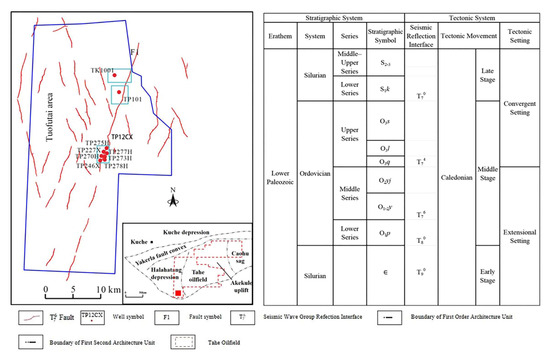
Figure 1.
Overview of the study area (modified from References [5,15]).
2. Reservoir Characterization of Fault-Controlled Karst Fracture–Vuggy Reservoirs
2.1. Reservoir Architecture Model
Building upon previous research on fault-controlled karst fracture–vuggy reservoirs [5,7,15] and incorporating geological characteristics of the study area, the reservoir architecture is classified into four fundamental elements: damage zone, fault core, fracture–vug complex, and cavern system, each exhibiting distinct geological signatures and geophysical responses (Table 1, Figure 2).

Table 1.
Structural elements and characteristics of fault-controlled karst reservoirs.
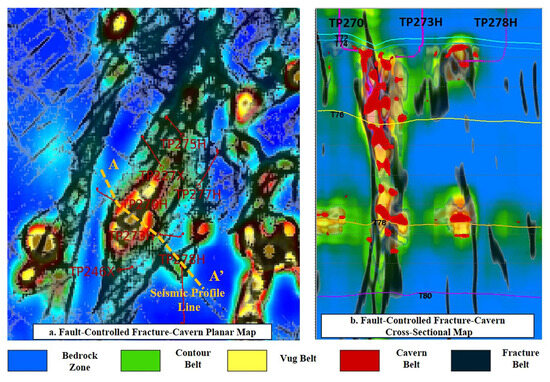
Figure 2.
Geological structural pattern of the fault-controlled karst reservoir.
- (1)
- Damage zone: The damage zone, representing the maximum influence range of strike-slip faults and serving as the outer boundary of fault-controlled karst fracture–vuggy reservoirs, features fracture-dominated effective storage spaces with partial dissolution-enhanced fracture development, typically exhibiting minor to negligible drilling fluid losses during operations, conventional logging responses including significant resistivity contrast between deep and shallow laterolog measurements, gamma ray signatures comparable to tight limestone intervals, and moderate rate of penetration (ROP) reduction, coupled with seismic reflection characteristics demonstrating slightly chaotic yet continuous wave patterns.
- (2)
- Fault core: The fault core, serving as the structural framework of fault-controlled karst fracture–vuggy reservoirs, develops as a mechanically damaged zone of specific width through torsional/shear stresses during strike-slip faulting, exhibiting gradual reduction in rock fragmentation intensity from the central core outward, with lithology dominated by tectonic breccias. Diagnostic signatures include significant acoustic log interval transit time variations, well-defined seismic structural attributes demonstrating clear reflection configurations, and distinct phase discontinuities during seismic events.
- (3)
- Vuggy zone: The vuggy zone, formed through dissolution-enhanced modification of fractured bedrock and dominated by small-scale dissolution pores, typically exhibits slight to negligible formation losses during drilling operations. Seismic signatures display chaotic reflection configurations with moderate amplitude anomalies, showing weaker energy characteristics compared to cavern systems, while conventional logging responses demonstrate significant rate of penetration (ROP) reduction, stable gamma ray readings, and moderate increases in acoustic transit time and neutron porosity values.
- (4)
- Cavern system: The cavern system exhibits the most intensive karst dissolution and represents the highest-quality reservoirs, demonstrating significant size variability with decimeter- to decameter-scale diameters (average > 5m) and irregular geometries. These large-scale cavernous reservoirs frequently experience collapse and infilling during burial diagenesis, with resistivity and density variations controlled by infill lithology heterogeneity. Seismic responses are characterized by prominent bead-like amplitude anomalies showing the strongest energy signatures among reservoir elements.
2.2. Reservoir Characterization Through Geophysical Classification
Based on the seismic response characteristics of reservoirs in the study area, an optimized suite of seismic attributes has been selected for characterizing different reservoir types: texture contrast attributes delineate damage zones, deep learning-enhanced coherence attributes define fault cores, energy envelope attributes map vuggy zones, and residual impedance attributes characterize cavern systems (Table 2).

Table 2.
Characteristic seismic attribute and corresponding threshold of different structural elements in fault-controlled karst reservoirs.
2.2.1. Damage Zone Characterization
The damage zone, predominantly composed of multi-scale fractures and fragmented rocks, exhibits chaotic seismic reflection patterns with irregular amplitude intensities. This textural coarseness correlates with fracture density, where increased seismic chaos indicates enhanced fracturing. Our methodology employs grayscale contrast textural attributes to amplify these differential features, achieving 3D damage zone characterization [24,28,29]. The workflow initiates with atomic decomposition-based frequency processing to remove high-frequency interference near the T74 reflector, followed by texture contrast analysis for spatial delineation, effectively mitigating T74-related amplitude artifacts while preserving fracture signatures.
The characterization profile (Figure 3) demonstrates that the atomic decomposition algorithm effectively eliminates interference from the T74 strong reflector while accurately preserving the influence boundaries of the strike-slip fault zone. The fracture–breccia zone exhibits well-defined external boundaries that align with chaotic regions in the original amplitude profile, demonstrating a characteristic upward-widening geometry where textural attribute intensity correlates with brecciation degree, with high-value upper zones indicating dense fracturing and intense rock fragmentation. This damage zone characterization reveals the complete architecture of fault-controlled karst fracture–vuggy reservoirs, with spatial variations in vertical extent and lateral width reflecting strike-slip fault segmentation characteristics including extensional, compressional, and pure-slip deformation regimes.
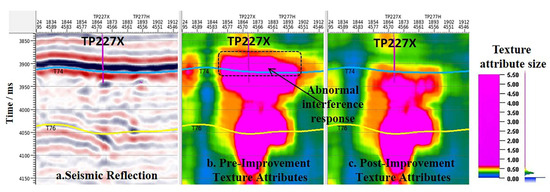
Figure 3.
Characterizing contour zone using texture contrast attributes.
2.2.2. Fault Core Characterization
Strike-slip fault zones represent the most distinctive features in fault-controlled karst fracture–vuggy reservoirs. Conventional manual interpretation of principal faults faces challenges including strong interpretational ambiguity and high labor costs, while traditional coherence-based attributes demonstrate inadequate vertical continuity for delineating deep-seated strike-slip fault systems. Recent advancements in deep learning prediction techniques offer novel approaches for fault zone characterization [30]. This study employs optimized fully convolutional neural network architectures, particularly U-Net models, which address the precision limitations of conventional neural networks in image recognition while demonstrating superior capability in 3D seismic interpretation.
U-Net, a deep learning model based on a convolutional neural network architecture, is widely employed for automated geological image recognition. The specific U-Net implementation used in this study consists of seven convolutional layers and four deconvolutional layers, utilizing a cross-entropy loss function to ensure effective multi-class recognition during training. We set the initial learning rate to 0.001 and employed the Adam optimizer. The model was trained for 50 epochs with a batch size of 32 samples, while implementing early stopping on the validation set to prevent overfitting. The dataset was partitioned into training and validation sets comprising 80% and 20% of the total data, respectively. To enhance model generalizability, the training set contains 1200 samples comprehensively covering diverse fault types and reservoir characteristics. We evaluated generalization capability through cross-validation and assessed model performance using metrics including the confusion matrix, precision, recall, and F1-score.
Through comprehensive training with 1200 annotated fault sections, the developed deep learning framework achieves 3D prediction of fault cores across the entire study area. The prediction profiles illustrate principal faults vertically penetrating target formations from deep to shallow intervals, extending downward to intersect the T80 formation. The deep learning system effectively identifies faults with measurable displacements and distinct seismic response contrasts between hanging wall and footwall blocks.
Meso-scale fractures typically originate from tectonic folding, fault activity, sedimentary processes, or diagenetic modification, presenting as anastomosing networks or directional alignments with lateral extensions ranging from meters to tens of meters. These fractures generally lack distinct displacement signatures in seismic data, manifesting as high-frequency chaotic reflections or weak-amplitude responses. The methodology employs third-generation eigenstructure coherence analysis to quantify waveform similarity, with parameter optimization demonstrating scale-dependent sensitivity: smaller calculation windows and reduced step intervals prove effective for meso-small fracture detection. Dip–azimuth enhancement processing combined with ant-tracking fault enhancement algorithms successfully resolves fracture clusters in both fault cores and steeply dipping folded zones. Figure 4b illustrates planar attribute extraction results comparing seismic-derived fracture networks with geological interpretations, confirming meso-small fracture concentration around principal fault zones.

Figure 4.
Prediction results of large-scale fault and meso/small fractures.
2.2.3. Vuggy Zone Characterization
Vuggy zones form through progressive dissolution enlargement of strike-slip fault breccias, primarily distributed within damage zones as adjacent contact features. This study employs amplitude energy envelope attributes for 3D characterization of dissolution-enhanced vuggy systems. The workflow integrates background trend suppression with phase-shift migration corrections on seismic data from representative structural units, deriving amplitude energy envelope attributes that delineate three-dimensional vuggy zone distributions as shown in Figure 5. Cross-sectional results demonstrate that suppressing background trends effectively mitigates T74 strong reflector interference while maintaining dissolution signatures. The analysis reveals enhanced dissolution intensity in upper reservoir intervals compared to lower sections, exhibiting vertical columnar geometries that reflect strike-slip-fault-controlled dissolution and compressional brecciation processes.
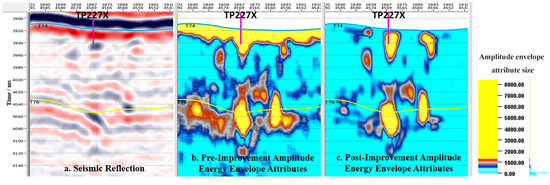
Figure 5.
Prediction results of dissolution pore zones.
2.2.4. Cavernous Zone Characterization
Macroscale caverns constitute the most extensively dissolved structural components within fault-controlled karst fracture–vuggy reservoirs, functioning as critical hydrocarbon storage spaces. Seismic manifestations typically exhibit bead–string reflection configurations correlated with drilling tool free-fall events. These caverns demonstrate reduced rock integrity and enhanced porosity relative to surrounding formations, resulting in diminished compressional wave impedance values due to velocity and density contrasts. This research employs advanced seismic inversion methodologies to eliminate wavelet distortion effects, achieving accurate spatial delineation of dissolution-enhanced cavern systems.
Validation of this methodology involved comprehensive case studies on macroscale cavern distribution. Initial seismic amplitude profiles (Figure 6a) clearly display bead–string reflection patterns characteristic of cavernous systems. The Tahe Block exhibits variable dissolution intensity, where weakly dissolved caverns demonstrate attenuated reflection energy that becomes obscured by host rock signatures. Conventional acoustic impedance inversion results (Figure 6b) reveal pronounced layered reflections from host formations intermingled with cavern signatures, complicating differentiation. To address this, the study implements host rock interference stripping through residual impedance extraction, calculated by subtracting background formation impedance from total impedance values. The resultant residual impedance profiles (Figure 6c) successfully isolate cavern heterogeneity patterns showing 95.2% correlation with drilling data. Vertical analysis demonstrates a progressive reduction in cavern dimensions and dissolution intensity with depth, confirming preferential upper-stratigraphic dissolution mechanisms characteristic of fault-controlled karst systems.

Figure 6.
Prediction results of the dissolution cave zone.
2.3. Reservoir Characterization Reliability
Following seismic attribute optimization, threshold-based delineation of reservoir geobody boundaries can be validated against drilling fluid loss points to confirm characterization reliability. This study implements the Otsu threshold segmentation algorithm from the image processing domain to calculate optimal thresholds for caverns, vugs, and fractures [31,32]. The method’s mathematical foundation maximizes inter-class variance between target reservoirs and background formations, yielding geologically consistent results when employing representative seismic attributes. Comparative analysis through Figure 7b demonstrates superior fracture–vug differentiation accuracy compared to conventional thresholding approaches.
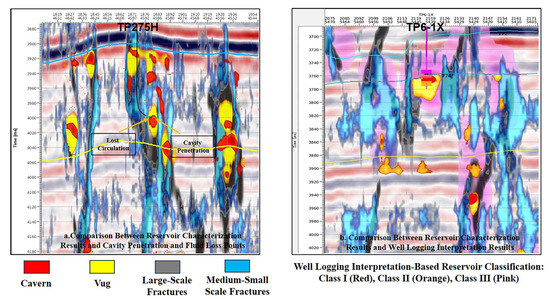
Figure 7.
Validation of seismic characterizing results by drilling signals (unloading and leakage) and well logging interpretation.
Application of image segmentation algorithms established reservoir property thresholds: cavern threshold at 415, vug threshold at 765, and fracture threshold at −0.6. In Well TP275H, both lost circulation zones and cavity penetration points precisely align with geophysically delineated cavern reservoirs (Figure 7a). Regional statistics demonstrate 91.2% correlation between geophysical reservoir interpretations and 31 cavity penetration events from drilling data, with all high-productivity wells intersecting premium reservoir compartments. Comparative analysis with well-log-derived reservoir classifications (Figure 7b) further confirms the strong correspondence between geophysical delineations and subsurface reservoir architectures. These findings confirm that the geophysical classification methodology reliably characterizes reservoir architecture.
3. Fault-Controlled Karst-Modified Fracture–Cavern Reservoir Geological Modeling
3.1. Structural Element Decomposition–Integration Modeling Methodology
This geological modeling workflow implements a hierarchically constrained progressive modeling approach comprising four sequential stages: Initially, Stage 1 constructs the structural framework model through strike-slip fault zone interpretation and vertical stratigraphic framework delineation. Stage 2 establishes external geometry models using truncated Gaussian simulation guided by contour belt attributes. Stage 3 implements deterministic modeling within the geometric constraints to characterize geophysically classified reservoir compartments. Finally, Stage 4 develops the petrophysical property model through geostatistical simulation methods under reservoir architecture constraints, with the complete workflow illustrated in Figure 8.
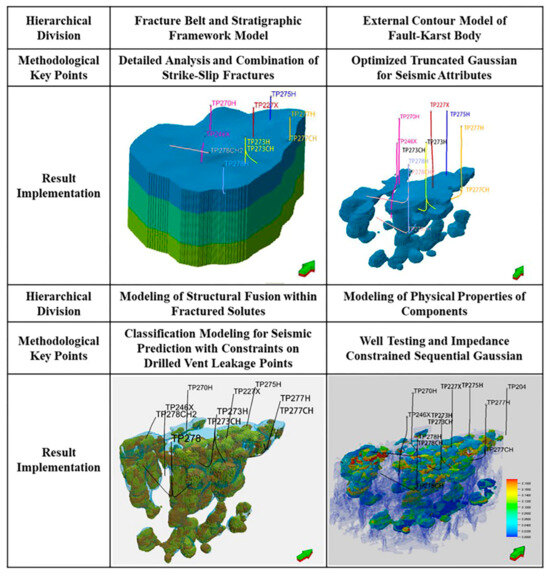
Figure 8.
The geological modeling process of structural element decomposition–fusion.
Traditional 3D modeling methods typically treat the entire region as a single entity, analyzing the geological body, reservoir, and properties holistically. These methods rely on global input data for one-time model creation, often neglecting constraint relationships between different geological layers. They lack a clear hierarchical structure and constraints, which can lead to insufficient model accuracy. In contrast, the structural element decomposition–integration modeling method is based on structural patterns of fault-controlled fracture–cavity bodies in reservoirs, summarized from field outcrop observations and drilling/logging response characteristics. It adopts a hierarchical modeling approach, applying constraints and optimizations at each level. The modeling result of each level is constrained by the previous level, thereby progressively enhancing model accuracy and bringing it closer to geological reality. This method avoids over-simplification or distortion of the model. Compared to traditional 3D modeling methods, this approach effectively improves modeling accuracy, enhances geological consistency, and offers greater flexibility and scalability. Each modeling level can be optimized according to different geological contexts and data, thereby increasing model reliability.
The 3D fracture–cavern reservoir modeling primarily employs seismic interpretation through deterministic approaches to establish reservoir architecture within strike-slip fault frameworks, constrained by limited well data. This methodology extracts fault-karst geological bodies based on seismic texture contrast attributes, utilizing grid resampling techniques to construct 3D fault-karst contour zone models. Contour zones function exclusively as geometric constraints, with valid reservoir compartments restricted to fracture zones, vug zones, and cavern zones.
3.2. Reservoir Compartment Model Construction
3.2.1. Fault-Fracture Modeling
As established in prior research, strike-slip fault zones and associated medium–large-scale fractures represent principal fracture types within the TP12CX fault zone. This study utilizes deep-learning-derived fault zone attributes to extract ant-tracking attributes reflecting fracture discontinuity. The workflow applies horizon-specific constraints (T74~T80) with well data calibration, achieving detailed fracture characterization through implementation of the predefined attribute threshold (−0.6), with visualization documented in Figure 9a.
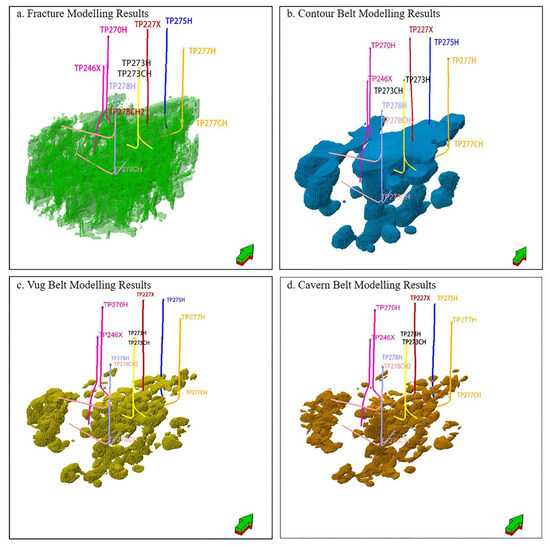
Figure 9.
Results of reservoir element modeling.
3.2.2. Cavern–Vug Modeling
Caverns and vugs constitute primary reservoir compartments within fault-controlled karst-modified fracture–cavern systems. Seismic attribute optimization demonstrates that energy envelope attributes effectively predict vug distributions, while residual impedance attributes delineate cavern architectures. Geophysical analysis establishes cutoff values at approximately 420 for energy envelope attributes in vug reservoirs and 765 for residual impedance attributes in cavern reservoirs. Under contour zone constraints, geophysically delineated vug and cavern geobodies are resampled into the 3D grid system, with deterministic geological modeling approaches yielding integrated cavern–vug reservoir models (Figure 9c,d).
3.2.3. Reservoir Compartment Integration
After constructing separate reservoir compartment models for fractures, vugs, and caverns, the three types require integration to generate a comprehensive model. Following the priority principle of caverns > vugs > fractures, the integration process achieves fused reservoir compartments, with representative well modeling illustrated in Figure 10. The modeling results demonstrate distinct spatial variation characteristics: fracture density progressively decreases from bottom to top, while vug density correspondingly increases. This spatial progression aligns with vertical development patterns of fault-karst reservoirs, where dissolution intensity exhibits a weakening trend downward along the T74 interface.
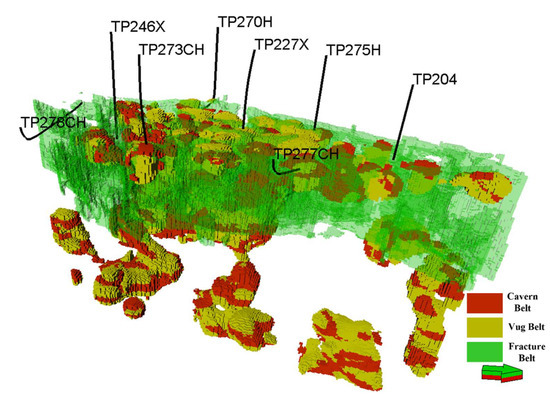
Figure 10.
Results of the coupled reservoir element model.
3.3. Petrophysical Model Construction
3.3.1. Porosity Modeling
The current mainstream porosity modeling methodology for fracture–cavern reservoirs involves extracting acoustic impedance and porosity data samples from drilled wells based on porosity inversion principles. These samples establish theoretical mathematical relationships between acoustic impedance and porosity, ultimately generating 3D porosity models [18]. However, this approach exhibits two limitations: high porosity values derived from theoretical data lead to overestimated cavern porosity, while deterministic porosity–acoustic impedance relationships hinder uncertainty assessment of modeling results.
This study employs a geostatistics-based porosity modeling methodology to establish reservoir porosity models. The workflow comprises three steps: (1) Determine porosity upper/lower bounds through acoustic impedance distribution characteristics combined with porosity–acoustic impedance crossplots; (2) calculate mean porosity values for caverns and vugs using statistical methods; (3) develop facies-constrained porosity models with acoustic impedance data as 3D constraints. Figure 11 presents porosity modeling results for representative units: cavern porosity ranges from 7.1 to 25.1% (mean 17.8%), vug porosity 0.6–4.9% (mean 3.5%), and fracture porosity 0.1%. The methodology applies facies control and seismic constraints to regulate 3D porosity trends and distribution ranges, yielding reliable models.
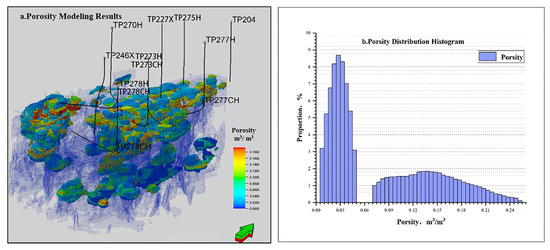
Figure 11.
Results of porosity model.
3.3.2. Permeability Modeling
Permeability modeling determines value ranges for caverns, vugs, and fractures based on well test data and empirical knowledge. Using porosity–permeability correlations as constraints, facies-controlled Gaussian simulation algorithms construct permeability models, which are iteratively calibrated through reservoir simulation. The final models under different reservoir constraints are shown in Figure 12. The results indicate that cavern permeability ranges from 60 to 800 mD (mean 587 mD), vug permeability from 0.1 to 39 mD (mean 25 mD), and fracture permeability averaging 1400 mD.
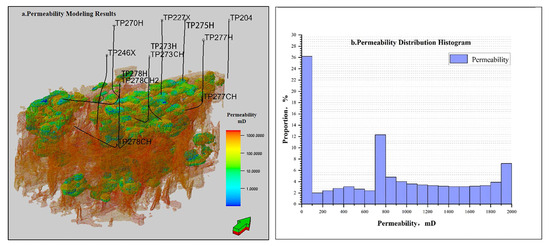
Figure 12.
Results of the permeability model.
3.3.3. Saturation Modeling
Saturation modeling involves two steps. The first step is determining compartmental oil–water contacts. Taking TP227X as an example, this compartment constitutes a unified pressure system. The TP275H well produced 20.8 m3 through natural flow and 1470.2 m3 via gas lift in 2017, totaling 1491 m3 with a 201% flowback ratio, yielding exclusively formation water without hydrocarbons. This confirms the oil–water contact at the TP275H well bottomhole depth of 6635 m (elevation −5670 m). The second step is establishing oil saturation values for different reservoir types. Due to insufficient reliable well log data, conventional Archie-equation-based saturation interpretation is inapplicable. Referencing the Tahe Oilfield and Shunbei Blocks 1/4/5 reserve reports combined with project production–geological analysis, final oil saturation values are determined: 80.1% for caverns, 74.9% for vugs, and 90.0% for fractures. The deterministic method constructs saturation models with 100% water saturation below the oil–water contact, and specified oil saturation values above the contact. Saturation modeling results are shown in Figure 13.
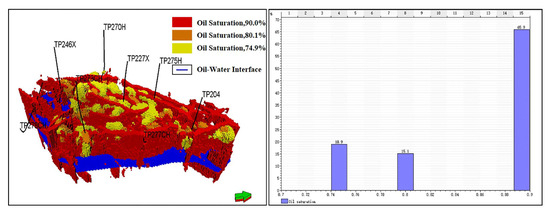
Figure 13.
Results of the saturation model.
4. Model Validation and Application
History matching constitutes the critical component of integrated reservoir modeling and simulation, serving as the primary method to evaluate reservoir characterization results [33]. By integrating dynamic and static data, history matching validates geological models, reveals remaining oil distribution, and provides model support for field development adjustments. The process comprises three hierarchical levels: geological reserve matching, compartment-level matching, and well-level matching. For geological reserves, the TP227X compartment previously estimated OOIP at 6.02 million tons with a cumulative oil production of 846,000 tons (14.1% recovery factor). However, the current comprehensive water cut of 68% indicates significant discrepancies between static reserves and production dynamics. This study recalculates OOIP through geophysical characterization and 3D geological modeling, obtaining 3.218 million tons with a corresponding recovery factor of 26.3%, which is better aligned with production trends. The OOIP is the product of model volume, average porosity, and average saturation. Reservoir pressure vividly reflects reservoir energy, indicating static connectivity and dynamic response characteristics. Figure 14a displays compartment static pressure matching results, showing strong consistency between simulated and actual reservoir pressures. Figure 14b presents oil–water production matching results, demonstrating good correspondence between simulated and observed production dynamics.
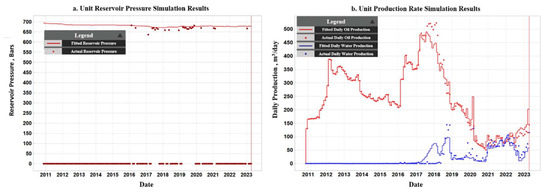
Figure 14.
History matching results of static pressure and production rate.
With satisfactory compartment-level matching results, production well-specific history matching was conducted to ensure numerical simulation accuracy of the remaining oil distribution. This process involved matching oil production rates, water production rates, bottomhole flowing pressures, and other indicators (Figure 15). The well-level matching achieved 85.3% consistency, demonstrating effective history matching outcomes.
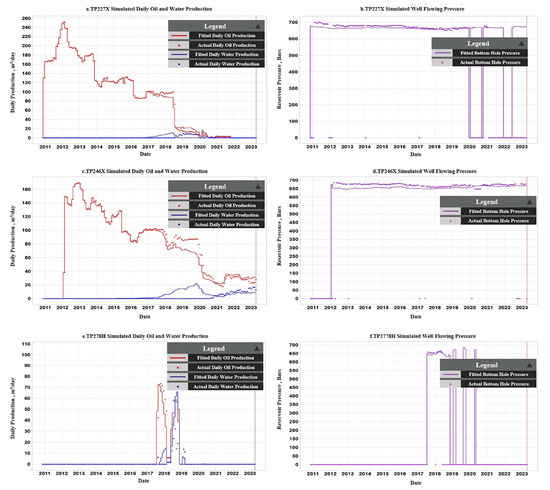
Figure 15.
History matching results of rate and bottomhole pressure of typical wells.
Connectivity relationships in the numerical model further validate its reliability. In March 2019, gas injection at TP273H caused pressure increases at TP275H, gas breakthrough in TP227X, and pressure elevation at TP246X, consistent with the well connectivity relationships shown in Figure 15a. In 2022, large-scale gas injection in TP227X resulted in water cut reduction at TP275H, gas breakthrough at TP277CH, water cut decline at TP246X, and gas breakthrough at TP273CH, aligning with the connectivity relationships revealed in Figure 16b.
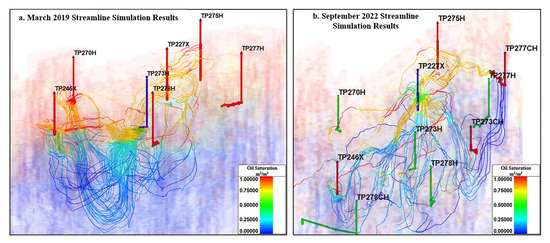
Figure 16.
Results of well connectivity relationships.
Based on history matching, nitrogen foam flooding simulations were performed for the TP227X well in the compartment core. The results show gas injection coverage extending to TP275H, TP277CH, and TP270H, with pre-injected foam effectively controlling gas channeling. Numerical simulations optimized parameters including injection rate, foam concentration, single-cycle gas volume, and injection cycles, providing theoretical support for field implementation. From 31 May to 25 July 2023, TP227X executed nitrogen foam flooding with eight gas injection cycles, two foam injection cycles, 3 million cubic meters of gas, and 2200 cubic meters of foam solution, achieving 3292 tons of incremental oil production. The reservoir characterization and geological modeling methodology presented in this study can be applied to middle–late-stage development management of fault-controlled karst reservoirs.
5. Conclusions
- (1)
- This study proposes a four-element structural model for fault-controlled fracture-cavern reservoirs, including contour belts, fracture belts, vug belts, and cavern belts. A geophysical classification methodology was developed utilizing texture contrast attributes, deep learning/coherence attributes, energy envelope attributes, and residual impedance attributes, achieving 91.2% consistency with cavity penetration and fluid loss points.
- (2)
- The structural element decomposition–integration modeling method was applied to establish the 3D geological model. Under contour belt constraints, deterministic modeling methods built integrated reservoir models combining fractures, caverns, and vugs. Facies-constrained geostatistical methods with trend data coordination established porosity, permeability, and saturation models. The models demonstrate petrophysical characteristics as follows: cavern reservoirs exhibit an average porosity of 17.8%, a permeability of 587 mD, and 80.1% saturation; vug reservoirs display a porosity of 3.5%, a permeability of 25 mD, and 74.9% saturation; fracture systems show a porosity of 0.1%, a permeability of 1400 mD, and 90% saturation.
- (3)
- The geological model reliability was validated through numerical simulation encompassing reserve matching, production matching, pressure matching, and dynamic connectivity verification. Nitrogen foam flooding simulations with parameter optimization were conducted using the model, achieving an incremental oil production of 3292 tons during field implementation, demonstrating significant operational effectiveness.
Author Contributions
Conceptualization, B.T.; Methodology, C.L., B.L. (Bo Liu) and W.L.; Software, W.L., C.G. (Chen Guo) and L.S.; Validation, B.L. (Bo Liu); Investigation, C.G. (Chunying Geng); Data curation, C.G. (Chunying Geng); Writing—original draft, B.T. and C.L.; Writing—review and editing, B.T.; Supervision, C.Y. and B.L. (Binglin Li). All authors have read and agreed to the published version of the manuscript.
Funding
This research was funded by National Science and Technology Major Project of China (grant number 2016ZX05053) and Science and Technology Department Project of Sinopec-China Petroleum (grant number P11089).
Data Availability Statement
The original contributions presented in this study are included in the article. Further inquiries can be directed to the corresponding author.
Conflicts of Interest
Authors Bochao Tang, Chenggang Li, Chunying Geng, Bo Liu, Wenrui Li, Chen Guo, Lihong Song and Chao Yu were employed by Sinopec Northwest Oilfield Company. The remaining author declares that the research was conducted in the absence of any commercial or financial relationships that could be construed as a potential conflict of interest.
References
- Li, Y. The Theory and Method for Development of Carbonate Fractured-Cavity Reservoirs in Tahe Oilfield. Acta Pet. Sin. 2013, 34, 115–121. [Google Scholar] [CrossRef]
- Tian, F.; Luo, X.; Zhang, W. Integrated Geological-Geophysical Characterizations of Deeply Buried Fractured-Vuggy Carbonate Reservoirs in Ordovician Strata, Tarim Basin. Mar. Pet. Geol. 2019, 99, 292–309. [Google Scholar] [CrossRef]
- Tang, B.C.; Geng, C.Y.; Huang, M.N.; Lu, H.T.; Ren, K. Research on the Depletion and Recovery Characteristics of Fault-Karst Reservoirs. Geofluids 2022, 2022, 1105335. [Google Scholar] [CrossRef]
- Li, Y.; Hou, J.G.; Li, Y.Q. Features and Classified Hierarchical Modeling of Carbonate Fracture-Cavity Reservoirs. Pet. Explor. Dev. 2016, 43, 655–662. [Google Scholar] [CrossRef]
- Lu, X.B.; Hu, W.G.; Wang, Y.; Li, X.H.; Li, T.; Lyu, Y.P.; He, X.M.; Yang, D.B. Characteristics and Development Practice of Fault-Karst Carbonate Reservoirs in Tahe Area, Tarim Basin. Oil Gas Geol. 2015, 3, 347–355. [Google Scholar] [CrossRef]
- Yun, L.; Zhu, X.X. A New Type: Fault-Controlled Fracture-Vuggy Trap. Oil Gas Geol. 2022, 43, 34–42. [Google Scholar] [CrossRef]
- Li, L.; Sun, T.B.; Chen, Y.N.; Zhang, Y.; Wang, Y.S.; Wang, S.; Zhao, J.; Wang, Y.D.; Li, D. Characteristics of Strike-Slip Faults and Exploration of Fault-Dissolution Body in Xiaotangnan Area of Tarim Basin. Bull. Geol. Sci. Technol. 2023, 42, 239–245. [Google Scholar] [CrossRef]
- Wang, Q.H.; Yang, H.J.; Wang, R.J.; Li, S.Y.; Deng, X.L.; Li, Y.; Chang, L.J.; Wan, X.G.; Zhang, Y.T. Discovery and Exploration Technology of Fault-Controlled Large Oil and Gas Fields of Ultra-Deep Formation in Strike Slip Fault Zone in Tarim Basin. China Pet. Explor. 2021, 26, 58–71. [Google Scholar] [CrossRef]
- Ding, Z.W.; Wang, R.J.; Chen, F.F.; Yang, J.P.; Zhu, Z.Q.; Yang, Z.M.; Sun, X.H.; Xian, B.; Li, E.P.; Shi, T.; et al. Origin, Hydrocarbon Accumulation and Oil-Gas Enrichment of Fault-Karst Carbonate Reservoirs: A Case Study of Ordovician Carbonate Reservoirs in South Tahe Area of Halahatang Oilfield, Tarim Basin. Pet. Explor. Dev. 2020, 47, 306–317. [Google Scholar] [CrossRef]
- Wang, Q.H.; Yang, H.J.; Li, Y.; Lv, X.X.; Zhang, Y.T.; Zhang, Y.Q.; Sun, C.; Ouyang, S.Q. Control of Strike-Slip Fault on the Large Carbonate Reservoir in Fuman, Tarim Basin—A Reservoir Model. Earth Sci. Front. 2022, 29, 239–251. [Google Scholar] [CrossRef]
- Ning, C.Z.; Sun, L.D.; Hu, S.Y.; Xu, H.M.; Pan, W.Q.; Li, Y.; Zhao, K.Z. Karst Types and Characteristics of the Ordovician Fracture-Cavity Type Carbonate Reservoirs in Halahatang Oilfield, Tarim Basin. Acta Pet. Sin. 2021, 42, 15–32. [Google Scholar] [CrossRef]
- Shang, X.F.; Duan, T.Z.; Zhang, W.B.; Cheng, H.; Liu, Y.F. Characterization of Dissolution Facies Belt in Fracture-Cavity Carbonate Rocks Mainly Controlled by Fault-Controlling Karst: A Case Study of Ordovician Reservoirs in the Block 10 of Tahe Oilfield. Acta Pet. Sin. 2020, 41, 329–341. [Google Scholar] [CrossRef]
- Wang, L.X.; Yin, Y.S.; Zhang, C.M.; Feng, W.J.; Li, G.Y.; Chen, Q.Y.; Chen, M. A MPS-Based Novel Method of Reconstructing 3D Reservoir Models from 2D Images Using Seismic Constraints. J. Pet. Sci. Eng. 2022, 209, 109974. [Google Scholar] [CrossRef]
- Han, J.F.; Su, Z.; Chen, L.X.; Guo, D.S.; Zhang, Y.T.; Ji, Y.G.; Zhang, H.F.; Yuan, J.Y. Reservoir-Controlling and Accumulation-Controlling of Strike-Slip Faults and Exploration Potential in the Platform of Tarim Basin. Oil Gas Geol. 2019, 40, 1296–1310. [Google Scholar] [CrossRef]
- Zhang, W.B.; Duan, T.Z.; Li, M.; Zhao, H.W.; Shang, X.F.; Wang, Y. Architecture Characterization of Ordovician Fault-Controlled Paleokarst Carbonate Reservoirs in Tuoputai, Tahe Oilfield, Tarim Basin, NW China. Pet. Explor. Dev. 2021, 48, 367–380. [Google Scholar] [CrossRef]
- Liu, J.; Ren, L.D.; Li, Z.J.; Wang, P.; Yang, Z.C.; Ma, L.W. Seismic Identification and Evaluation of Deep Carbonate Faults and Fractures in Shunnan Area, Tarim Basin. Oil Gas Geol. 2017, 38, 703–710. [Google Scholar] [CrossRef]
- Liu, B.Z.; Qi, L.X.; Li, Z.J.; Liu, J.; Huang, C.; Yang, L.; Ma, L.W.; Gong, W. Spatial Characterization and Quantitative Description Technology for Ultra-Deep Fault-Karst Reservoirs in the Shunbei Area. Acta Pet. Sin. 2020, 41, 412–420. [Google Scholar] [CrossRef]
- Li, H.Y.; Liu, J.; Gong, W.; Huang, C.; Ren, L.D. Identification and Characterization of Strike-Slip Faults and Traps of Fault-Karst Reservoir in Shunbei Area. China Pet. Explor. 2020, 25, 107–120. [Google Scholar] [CrossRef]
- Hu, X.Y.; Li, Y.; Quan, L.S.; Kong, Q.Y.; Wang, Y.; Lv, X.R. Three-Dimensional Geological Modeling of Fractured-Vuggy Carbonate Reservoirs: A Case from the Ordovician Reservoirs in Tahe-IV Block, Tahe Oilfield. Oil Gas Geol. 2013, 34, 383–387. [Google Scholar] [CrossRef]
- Hu, X.Y.; Yuan, X.C.; Hou, J.G.; Quan, L.S. Modeling Method of Carbonate Fractured-Cavity Reservoirs Using Multiscale Karst Facies-Controlling. Acta Pet. Sin. 2014, 35, 340–346. [Google Scholar] [CrossRef]
- Li, Y.Q.; Hou, J.G.; Liu, Y.M.; Li, C.X.; Ma, X.Q.; Han, D. 3D Modeling of Cave Reservoirs Based on Karst Patterns. J. China Univ. Pet. (Ed. Nat. Sci.) 2016, 40, 43–50. [Google Scholar] [CrossRef]
- Zhang, W.B.; Duan, T.Z.; Zhao, H.W.; Ma, Q.Q.; Bao, D. Hierarchical Characteristics and 3D Modeling of Fault-Controlled Paleokarst Systems: A Case Study of Shunbei1 Strike-Slip Fault Zone. Sci. Technol. Eng. 2021, 21, 12094–12108, (In Chinese with English Abstract). [Google Scholar]
- Zhang, W.B.; Zhang, Y.X.; Duan, T.Z.; Li, M.; Zhao, H.W.; Wang, Y. Hierarchy Modeling of the Ordovician Fault-Karst Carbonate Reservoir in Tuoputai Area, Tahe Oilfield, Tarim Basin, NW China. Oil Gas Geol. 2022, 43, 207–218. [Google Scholar] [CrossRef]
- Zhang, W.B.; Duan, T.Z.; He, Z.L.; Zhao, H.W.; Liu, Y.F.; Bao, D. Hierarchical Constraint Geological Modelling Method for Carbonate Paleokarst Caves: A Case Study of Ordovician Fracture-Cavern Unit in Tahe Oilfield. Bull. Geol. Sci. Technol. 2022, 41, 273–281. [Google Scholar] [CrossRef]
- Wang, J.H.; Jiao, B.L.; Zeng, W.G.; Li, D.; Ge, J.J. Development Mode of Tahe Fracture—Cave Reservoirs Inlate Water Flooding Stage. Spec. Oil Gas Reserv. 2015, 22, 125–128. [Google Scholar]
- Li, J.H.; Feng, Y.B.; Wang, J.H.; Xu, Z.X.; Li, B.F.; Zhang, C. Study on Formation and Migration Law of Foam in Fractures and Its Influencing Factors. Acs Omega 2024, 9, 24362–24371. [Google Scholar] [CrossRef] [PubMed]
- Yang, Y.D.; Rong, G.; Xin, Y.; Song, Y.J.; Li, B.F. Visualization Experimental Investigation on Flow Regulation and Oil Displacement Characteristics of Gel Foam in Fractured-Vuggy Carbonate Reservoirs. Acs Omega 2024, 9, 40810–40820. [Google Scholar] [CrossRef] [PubMed]
- Gao, D.L.; Duan, T.Z. Seismic Structure and Texture Analyses for Fractured Reservoir Characterization: An Integrated Workflow. Interpret. A J. Sub. Charact. 2017, 5, T623–T639. [Google Scholar] [CrossRef]
- Zhang, W.B.; He, Z.L.; Duan, T.Z.; Ma, Q.Q.; Li, M.; Zhao, H.W. Architecture Characteristics and Characterization Methods of Fault-Controlled Karst Reservoirs: A Case Study of the Shunbei 5 Fault Zone in the Tarim Basin, China. Interpret. A J. Sub. Charact. 2023, 11, SA47–SA62. [Google Scholar] [CrossRef]
- Wu, X.M.; Liang, L.M.; Shi, Y.Z.; Fomel, S. Faultseg3D: Using Synthetic Data Sets to Train an End-to-End Convolutional Neural Network for 3D Seismic Fault Segmentation. Geophysics 2019, 84, IM35–IM45. [Google Scholar] [CrossRef]
- Otsu, N. A Threshold Selection Method from Gray-Level Histograms. IEEE Trans. Syst. Man Cybern. 1979, 9, 62–66. [Google Scholar] [CrossRef]
- Zhao, H.; Li, M.; Zhang, W.; Ma, Q.; Tian, M.; Duan, T. An Ensemble Algorithm to Determine the Optimal Threshold of Seismic Attribute Characterizing Fault-Controlled Karst Reservoir. Fifth EAGE Conference on Petroleum Geostatistics. Eur. Assoc. Geosci. Eng. 2023, 1, 1–5. [Google Scholar] [CrossRef]
- Liu, P.L.; Jiang, L.; Tang, B.C.; Ren, K.; Huang, M.N.; Geng, C.Y. Residual Oil Distribution Pattern in a Fault-Solution Carbonate Reservoir and Countermeasures to Improve Oil Development Effectiveness. Geofluids 2022, 2022, 2147200. [Google Scholar] [CrossRef]
Disclaimer/Publisher’s Note: The statements, opinions and data contained in all publications are solely those of the individual author(s) and contributor(s) and not of MDPI and/or the editor(s). MDPI and/or the editor(s) disclaim responsibility for any injury to people or property resulting from any ideas, methods, instructions or products referred to in the content. |
© 2025 by the authors. Licensee MDPI, Basel, Switzerland. This article is an open access article distributed under the terms and conditions of the Creative Commons Attribution (CC BY) license (https://creativecommons.org/licenses/by/4.0/).